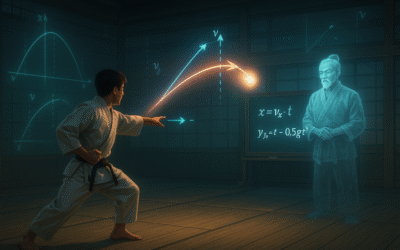🥋 Vectors – White to Black Belt Mastery
Intro Quote
“Direction gives strength its purpose. Without it, even power is lost.”
White Belt – Key Concept
Vectors have both magnitude and direction.
Scalars only have magnitude.
Examples:
- Velocity is a vector.
- Speed is a scalar.
Core Principles
- A vector can be written with an arrow symbol (A⃗).
- Components break a vector into x- and y-parts.
- Magnitude is found using Pythagoras.
- Direction is the angle measured from the positive x-axis.
- Vectors can be added graphically or algebraically.
Key Equations (SI Units)
Magnitude
|A| = √(Aₓ² + Aᵧ²)
Direction
θ = tan⁻¹(Aᵧ / Aₓ)
Components from polar
Aₓ = |A| cos θ
Aᵧ = |A| sin θ
Resultant of two vectors
R⃗= A + B⃗ = (Aₓ + Bₓ, Aᵧ + Bᵧ)
Symbols:
- A⃗, B⃗ = vectors
- Aₓ, Aᵧ = components (m, m/s, N, etc.)
- θ = direction (degrees or radians)
- |A| = magnitude
Common Mistakes and Pitfalls
- Forgetting the angle when describing a vector.
- Mixing up scalars and vectors.
- Wrong sign for components.
- Using tan⁻¹ without checking the quadrant.
🥋 Sensei’s Shortcuts
- Always sketch the vector.
- Break into components before combining.
- Keep units consistent.
- Double-check the quadrant of the angle.
Worked Example – Step by Step (White Belt)
Problem:
A⃗ has magnitude 12.0 m at 37° above the x-axis. Find Aₓ and Aᵧ.
Step 1. Formula
Aₓ = |A| cos θ
Aᵧ = |A| sin θ
Step 2. Substitution
Aₓ = 12.0 m × cos 37°
Aᵧ = 12.0 m × sin 37°
Step 3. Final Answer (3SF)
Aₓ = 9.58 m
Aᵧ = 7.22 m
Practice Drill (with answers)
- A⃗ has |A| = 15.0 m at 60°. Find Aₓ, Aᵧ.
- Answer: Aₓ = 7.50 m, Aᵧ = 13.0 m
- A⃗ = (8.00, 6.00) m. Find |A⃗| and θ.
- Answer: |A| = 10.0 m, θ = 36.9°
Yellow Belt Extension – Deeper Skills
Problem:
A⃗ = (10.0, 5.00) m
B⃗ = (−4.00, 12.0) m
Find R⃗, its magnitude, and its direction.
Solution Outline:
- R⃗ = (10.0 − 4.00, 5.00 + 12.0) = (6.00, 17.0) m
- |R| = √(6.00² + 17.0²) = 18.0 m
- θ = tan⁻¹(17.0 / 6.00) = 70.3°
Final Answer (3SF):
R⃗ = (6.00, 17.0) m
|R| = 18.0 m
θ = 70.3°
Extra Practice:
C⃗ = (−7.00, −24.0) m → |C| = 25.0 m, θ = 253°
Black Belt Mastery – Exam Strategy and Challenge
Problem:
A river flows east with velocity W⃗ = (2.50, 0) m/s.
A boat heads north at 3.00 m/s relative to the water.
Find the boat’s velocity relative to the ground.
Strategy Notes:
- Treat river and boat velocity as vectors.
- Add components.
- Find magnitude and direction.
Solution:
V⃗ = (2.50, 3.00) m/s
|V| = √(2.50² + 3.00²) = 3.91 m/s
θ = tan⁻¹(3.00 / 2.50) = 50.2° north of east
Final Answer (3SF):
V⃗ = (2.50, 3.00) m/s
|V| = 3.91 m/s
θ = 50.2° north of east
Sensei’s Final Words
“A vector without direction is only half the story. Always train with both eyes open.”


0 Comments